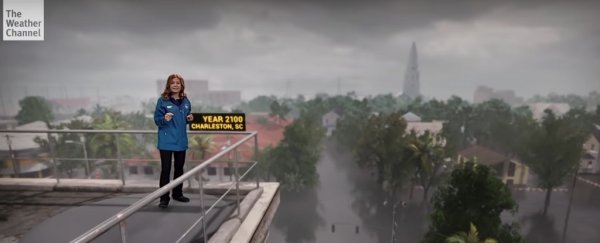Lately, the Weather Channel has been splashing out on some seriously disturbing graphics, and the channel's most recent immersion experience is absolutely brimming with disaster.
The roughly two-minute-long, mixed-reality segment takes viewers on a journey to the year 2100, when the streets of Charleston, South Carolina are perennially flooded, rendering parts of the city uninhabitable.
It's one of the most dire forecasts on the channel to date, and as meteorologist Jen Carfagno walks us through this reality, the consequences are clear to see.
As our oceans inch ever upwards, the United States' entire coastline will face unparalleled challenges, and cities like Charleston, which are at or below sea level, will be the first to suffer.
"Climate projections from decades ago have come to fruition, and unfortunately humans ignored the warnings," says Carfagno, setting the scene for the segment.
"Warnings that are visible now."
Using verifiable sea level estimates from NOAA and the United Nations' Intergovernmental Panel on Climate Change, the channel's graphics are based not on the worst case scenario - which could be construed as overly dramatic - but on "higher-end" predictions.
Comparing the flooded streets of a future Charleston to the current-day city of Norfolk, Virginia, Carfagno is able to show how this sort of flooding is already happening on a near-annual basis.
"Over the past 100 years, seas here have risen around one and a half feet partly because of what's happening thousands of miles away where the warning signs are the largest: the Arctic, the fastest-warming area on Earth," says Carfagno.
The issue is primarily due to melting glaciers, like the famed Jakobshavn Glacier in West Greenland, which has been shedding its ice at an unprecedented rate for some two decades.
So far, over half the Arctic's permanent ice has melted, and according to a report by the UN last year, we are past the point of no return.
Greenland alone contains over six metres (20 feet) of potential sea level rise, and today, the disappearance of Jakobshavn Glacier is stark and unsettling.
From where Carfagno stands on an icy outcrop, the beginning of the Jakobshavn Glacier looms in the distance. Yet as the years begin to roll back, and the glacier grows to its former glory in 1851, Carfagno finds herself within metres of the frozen wall.
"What you're watching is over 25 miles of ice, piled thousands of feet high," describes Carfagno.
None of that is left there today.
The U.S. has nearly 12,000 miles of coastline. For the millions of people living along those shores, rising seas are already becoming an issue. @JenCarfagno takes a deeper look. pic.twitter.com/nWG5BbsBka
— America’s Morning Headquarters (@AMHQ) April 9, 2019
Yet as informative and terrifying as these graphics are, some viewers are not fully satisfied.
While the channel certainly frames climate change as the ultimate culprit, the primary cause of these changes - namely, the emission of greenhouse gases by humans - is never mentioned. Nor is there a call to action.
This is obviously a huge omission, but even then, the immersive segment is a good start for an issue that is rarely discussed on the news, and is even more infrequently visualised by the public.
"Anything that can help people imagine what the future will look like - which is otherwise invisible - can be a very powerful communication tool," Anthony Leiserowitz, director of the Yale Program on Climate Change Communication, told Wired.
"It depends on the actual visualisation though, how realistic and convincing it is."
The Weather Channel's graphics may be grim and at times over-the-top, but their necessity is clear to see.
